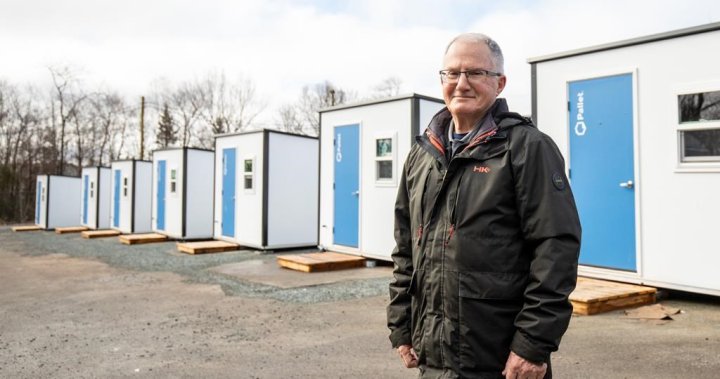Three neat rows of tiny shelters, each with a bright blue, lockable door, are up and occupied in a quiet Halifax suburb as the provincial government gradually rolls out what it is touting as an important part of its solution to homelessness.
Standing near the gated entrance to the community, Jim Gunn, a board member of Beacon House Shelter, describes the boxy 70-square-foot Pallet shelters — carrying the name of the U.S. company that makes them — as a temporary solution.
“Our greatest concern is that these should never become and be seen as permanent, but there’s no affordable housing,” the retired educator said during a recent tour of the property in Lower Sackville, about three weeks after it opened. “These shelters will stay here until we find someplace else people can go.”
The province is following the lead of Kelowna, B.C., and 124 other sites in North America, by bringing in the units assembled from insulated fibreglass panels. They’re manufactured by Pallet Shelter Inc., a for-profit, social-enterprise corporation based in Everett, Wash., which has now deployed about 5,000 of the shelters in North America and has been expanding in Canada.
The $630,000 installation, which includes 19 sleeping units, separate washrooms and a laundry facility, is part of the province’s $7.5-million purchase of 200 Pallet shelters. Nova Scotia says it is the first provincial government to make such a purchase from the U.S. manufacturer.
In the early weeks after the Lower Sackville project was announced for land next to Beacon House’s existing shelter, the non-profit and its faith-based board of directors faced a backlash. There were online petitions opposing the site and about 170 people attended a public meeting where some criticized its location near a school and community recreation facility.
The email you need for the day’s
top news stories from Canada and around the world.
The email you need for the day’s
top news stories from Canada and around the world.
“I’m really concerned, because we want to be good neighbours,” said Gunn, adding that his group is determined to shift public perceptions.
Among his key messages: there is a support system for the residents of the new community funded by $900,000 annually from the province. That includes two housing support workers in the shelter next door — one of whom is a social worker — and a mental-health counsellor who is also available once a week. A team of volunteers from faith and other community groups prepare meals for the residents.
Gunn also notes those selected to move into the units are required to “be able to live responsibly and respectfully” and must sign an agreement including 38 rules and warnings of potential removal if the community’s standards aren’t met.
When The Canadian Press visited the site, Beacon House didn’t permit any interviews with residents, and efforts to reach the residents through independent support groups were unsuccessful.
Amy King, the co-founder of Pallet, said in a telephone interview she expects the community opposition will shift toward support as they observe the results.
“Typically, people are afraid of what they don’t know. But we also have a lot of great data coming out of sites showing reductions of crime, of up to 30 per cent,” in neighbourhoods where Pallet shelters are installed, she said.
King said the security measures, including a chain-link fence, are designed to protect the residents — not enclose them.
“It’s a common myth that people experiencing homelessness engage in criminal activity. … the vast majority are victims of predatory behaviour — drug abuse, prostitution, things like that — brought to their doorsteps because of their vulnerability,” she said. King says the name of the company is based on the definition of pallet as a straw mattress, which she said evokes people being “lifted from their current circumstances and moved toward something better.”
Nikki Greer, the president of the non-profit group that supported the residents of a tent encampment in Lower Sackville, said in an interview only two of its former residents are staying in the Pallet homes.
She says proximity to a bus route and access to food are positive features, but she worries whether existing support is enough for people who have been “sleeping rough” for years. “Additional support is needed for these individuals … I just wish we had more support for the root causes of being unhoused,” she said.
Suzanne Ley, the director of income assistance at the provincial Department of Community Services, said in a telephone interview that the Pallet neighbourhoods are viewed by the province as “transitionary units for people to be able to get back on their feet.”
Asked how long it’s expected people will live there, Ley said that will depend on the availability of housing. “We would hope that folks are able to access housing quickly and can move out and open up the space for others,” she said.
The province’s next site for Pallet homes will be in Kentville, an Annapolis Valley town with a population of about 6,000, where 20 of the units will be installed next to a provincial building in the town. However, Ley doesn’t have an answer yet on whether all of the 200 units will be in place around the province before next winter, saying her team is still looking for suitable locations and more partners like Beacon House.
Gunn says while his group is pleased to help the homeless, his hope is that the structures — which can be easily disassembled and moved — won’t be on the property for decades. “We’re worried that temporary will be longer than we want it to be,” he said.
This report by The Canadian Press was first published March 18, 2024.
© 2024 The Canadian Press


